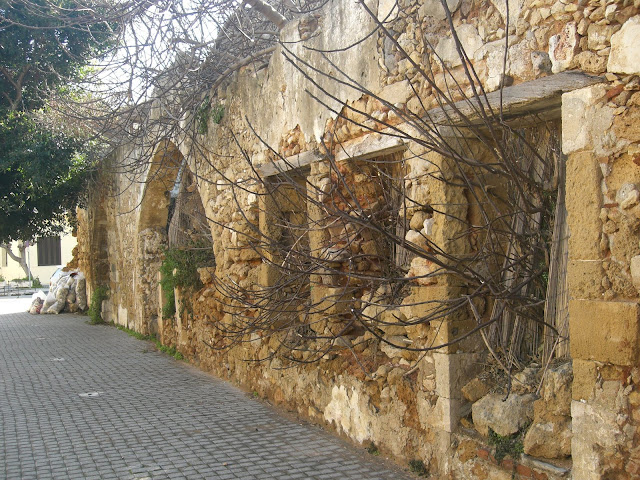As Greece faces crisis afer crisis, I'm just patiently waiting for the tide to recede. There's too much happening on all fronts in this country, creating widely diverging opinions and extremism. In the interim, we have to face the facts and get on with life. Crete is getting ready to become host to many millions of people starting from this week: not refugees, as we were led to believe given the various (non-)agreements between Turkey and the EU, but tourists, as the high season kicks off with an early calendar Easter. Let's see where this will lead...
To pass away the time, I've been working on little creative sewing projects to while away the quiet hours, the calm before the storm, so to speak. I poured out a bag full of scrippy scraps of denim cuts and starting plotting them onto a sturdy piece of age-stained vintage 50s calico cotton mad in Greece, originally used as storage sacks.
 In essence I had made new fabric from old fabric.
In essence I had made new fabric from old fabric.
 I liked the idea of not wasting anything, but I have gotten tired of small projects. I still like to keep my creative fabric art functional, meaning that a finished product must have a specific use, hence the idea for a pouffe, which I first saw on pinterest, So I became a bit more adventurous ...
I liked the idea of not wasting anything, but I have gotten tired of small projects. I still like to keep my creative fabric art functional, meaning that a finished product must have a specific use, hence the idea for a pouffe, which I first saw on pinterest, So I became a bit more adventurous ...
 ... until I ran out of scraps and needed to 'create' more! The last piece of of fabric had a more traditional patchwork look.
... until I ran out of scraps and needed to 'create' more! The last piece of of fabric had a more traditional patchwork look.
 I have plenty of mattressing remnants from my local mattreess maker (which reminds me: it's hotel preparation time - there are probably HEAPS of mattress remnants going to the recycling depot...), which I used to stuff the pouffe. I also made a 'handle' from the wasitline of an old pair of jeans to pull or carry it when moving it around the house.
I have plenty of mattressing remnants from my local mattreess maker (which reminds me: it's hotel preparation time - there are probably HEAPS of mattress remnants going to the recycling depot...), which I used to stuff the pouffe. I also made a 'handle' from the wasitline of an old pair of jeans to pull or carry it when moving it around the house.
 And here is the final product, something useful that will be enjoyed by many people.
And here is the final product, something useful that will be enjoyed by many people.
 It still needs a bit more stuffing, but that can be easily solved by sewing one side seam with a zip - taken directly from an old pair of jeans!!! No fuss sewing a zip on it from scratch!
It still needs a bit more stuffing, but that can be easily solved by sewing one side seam with a zip - taken directly from an old pair of jeans!!! No fuss sewing a zip on it from scratch!
It sounds easy enough, to tear up old jeans in order to embark on a similar project, but it's not that simple. This project started with a quilt made from large denim squares from old jeans:
 The resulting scraps were turned into smaller denim squares form another quilt:
The resulting scraps were turned into smaller denim squares form another quilt:
 The pouffe was the result of the scraps of the scraps of the scraps.
The pouffe was the result of the scraps of the scraps of the scraps.

 It takes a lot of creativity to be both sustainable AND functional!
It takes a lot of creativity to be both sustainable AND functional!
©All Rights Reserved/Organically cooked. No part of this blog may be reproduced and/or copied by any means without prior consent from Maria Verivaki.
To pass away the time, I've been working on little creative sewing projects to while away the quiet hours, the calm before the storm, so to speak. I poured out a bag full of scrippy scraps of denim cuts and starting plotting them onto a sturdy piece of age-stained vintage 50s calico cotton mad in Greece, originally used as storage sacks.






It sounds easy enough, to tear up old jeans in order to embark on a similar project, but it's not that simple. This project started with a quilt made from large denim squares from old jeans:




©All Rights Reserved/Organically cooked. No part of this blog may be reproduced and/or copied by any means without prior consent from Maria Verivaki.












































